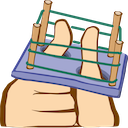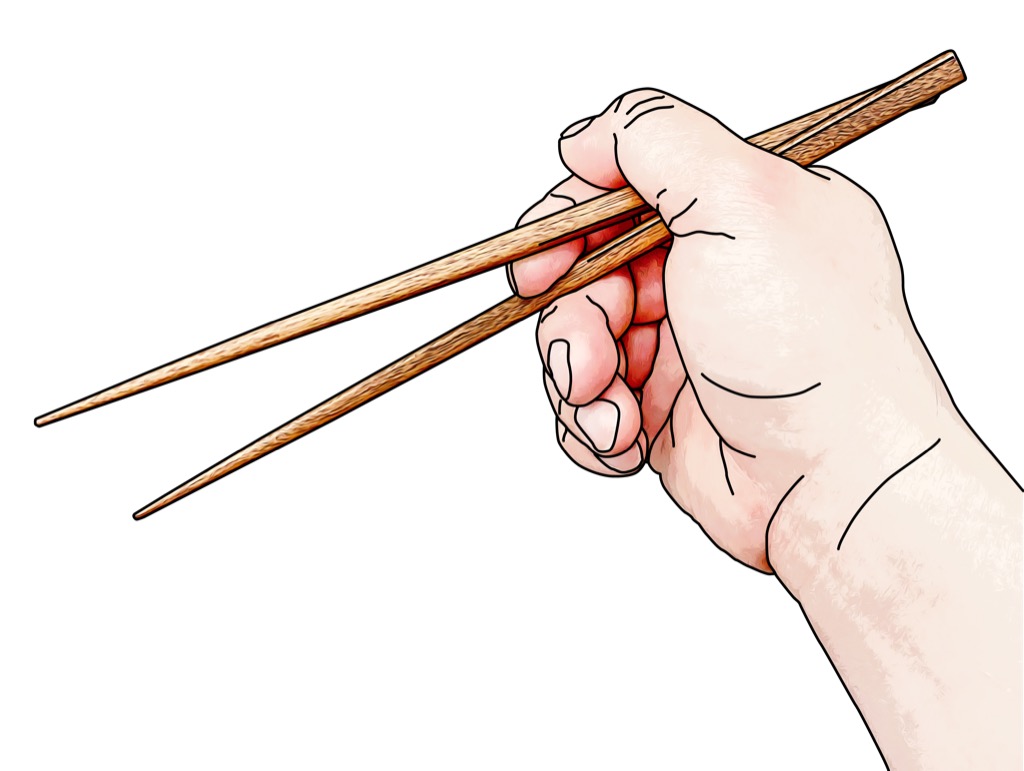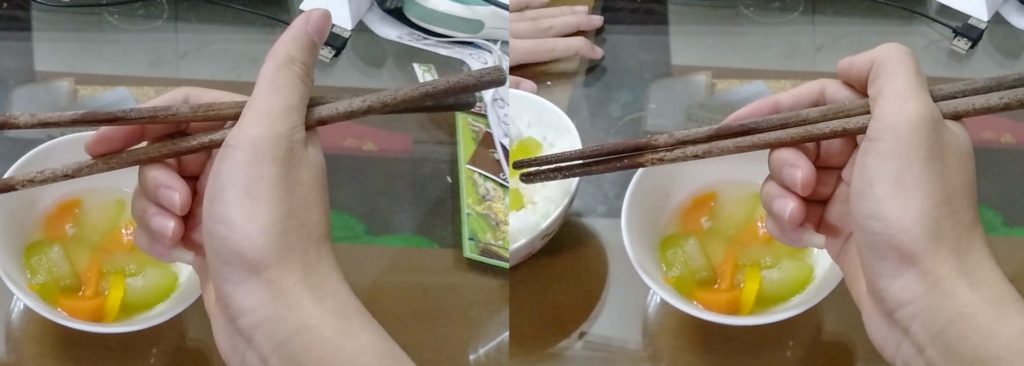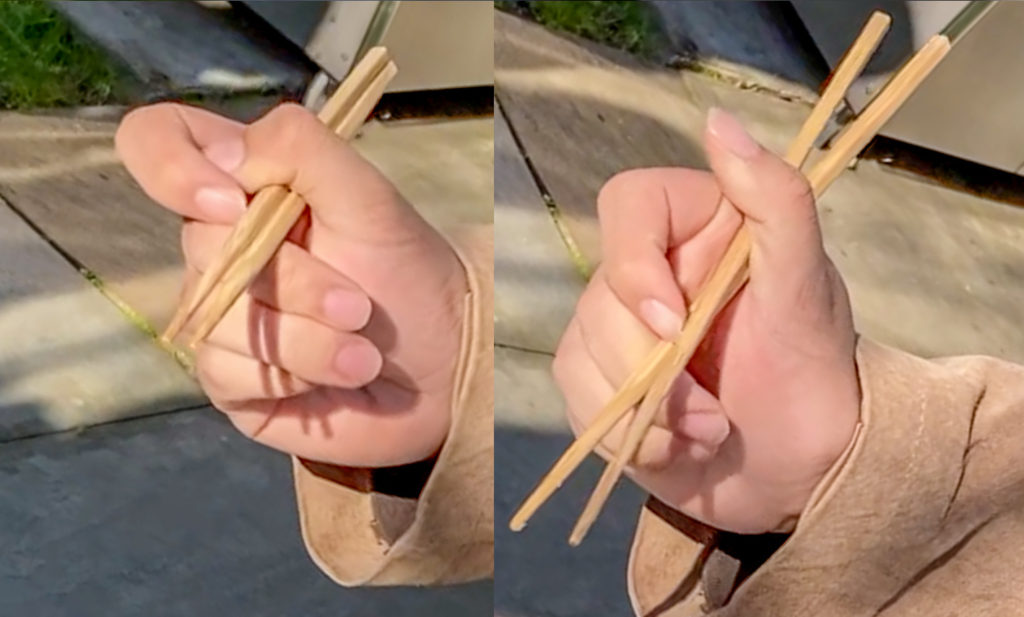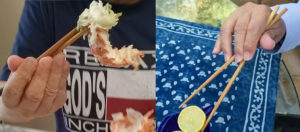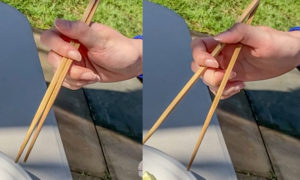Last Updated on 2021 年 06 月 30 日 by 編輯
Lateral Thumb Wrestler is a Lateral variant where the top chopstick is swung down veering left. This is known an underswing grip. It belongs to the largest grip family called Lateral grips. Lateral Thumb Wrestler employs the thumb to operate the top chopstick as if thumb-wrestling.
This article describes unique features in Lateral Thumb Wrestler. See parent article Lateral chopstick grips for aspects that Lateral Thumb Wrestler shares with the rest of its family members, including Lateral Squid and Lateral Gangnam Style.
內容目錄
The name
Look at the Open posture of Lateral Thumb Wrestler shown below left. Note how the thumb is extended straight and all the way out, almost as if making a thumbs-up gesture. That is how this grip nudges the top chopstick to extend chopsticks apart. Now, look at a picture from the World Thumb Wrestling Championship from 2019, found below right. Now you see why we named it Lateral Thumb Wrestler, right?
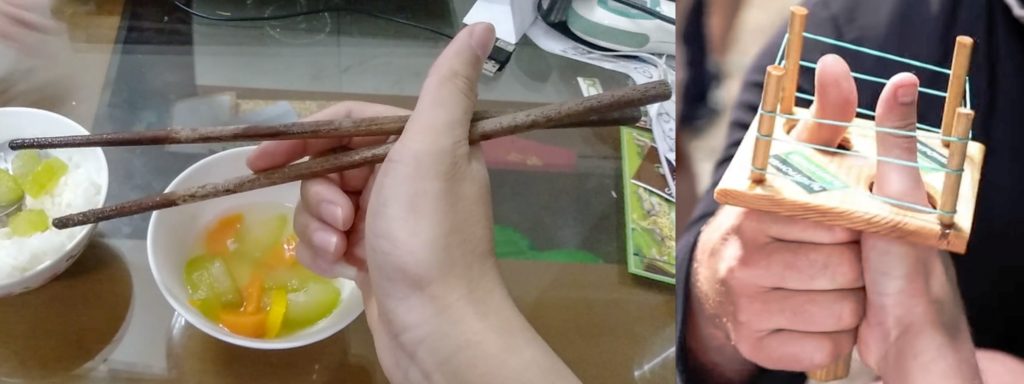
If you still have any remaining doubt about the name, then look at the Abutting posture shown below left. Compare this chopstick posture to the wresting picture shown below right. It depicts the moment the winner of a round pinned his opponent immobile. The same finger dynamics is used by Lateral Thumb Wrestler to snap two chopsticks closed.
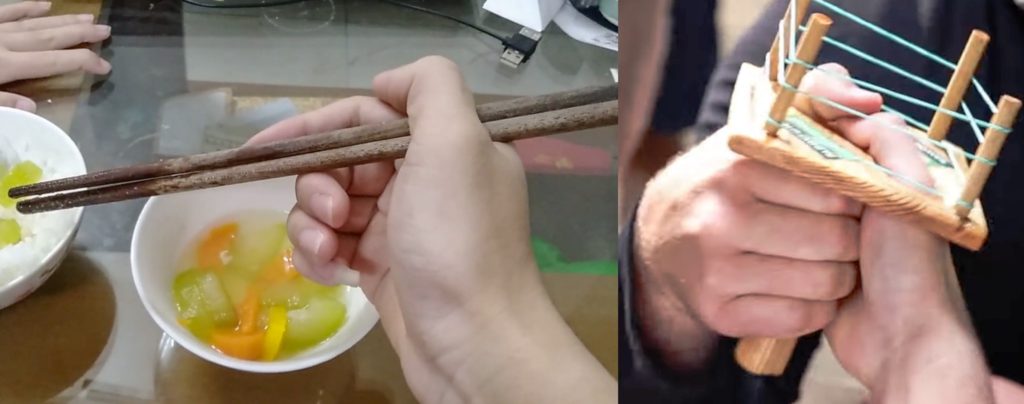
Now we show a video clip of this chopsticks grip alongside that of the thumb wrestling championship. The short video clip on the right is an excerpt from World Thumb Wrestling Championship at YouTube, by Britclip.
Key postures of this grip are shown below. From left to right, they are: 1) Abutting posture, 2) Compression posture, 3) Index Compression posture, 4) Closed posture, and 5) Open posture.


An underswing variant
We have previously identified a new factor to describe and classify related chopstick grips, based on how the top chopstick swings, in variant grips. This is detailed in Out with the Crossed Type, in with the Under Swing. Using the insight, we have classified all Lateral grips based on three types of swings: 1) classic swing, 2) sideway swing, and 3) underswing.
Lateral Thumb Wrestler is an underswing variant in this large Lateral grip family. Following short video illustrates its alternating motion, where the practitioner extends chopsticks apart, and then snap them back closed. Unlike its classic swing siblings in the Lateral family, Lateral Thumb Wrestler swings the top chopstick left and downward.
Following short video illustrates how this underswing chopstick movement is used in picking up and dropping off food.
Extending chopsticks apart
To extend chopsticks apart, this grip uses primary the base of the thumb. The index finger and the middle finger provide secondary assistance. Following sequence of images show the thumb base nudge the rear end of the top chopstick out of the abutting posture. The middle finger curls inward, and slightly downward, letting the front of the bottom chopstick drop down. The index finger sits on the bottom chopstick, stabilizing it against the middle finger, and the purlicue.

Here is another practitioner demonstrating his take of Lateral Thumb Wrestler. Compare it to User55. This camera angle clearly demonstrates the role of the thumb base on nudging the top chopstick, as well as the curling motion of the middle finger. This practitioner gives the index finger a more active role. The index finger forcefully pries the two chopsticks open. Note that this is a slow-motion capture. Actual movements are too fast for the eyes.
Key moments in the above video are shown below. Follow movements of individual fingers, one at a time. Start with the thumb base. Then follow the tip of the index finger. Appreciate how these two fingers coordinate to pivot the top chopstick around a mid point between them.
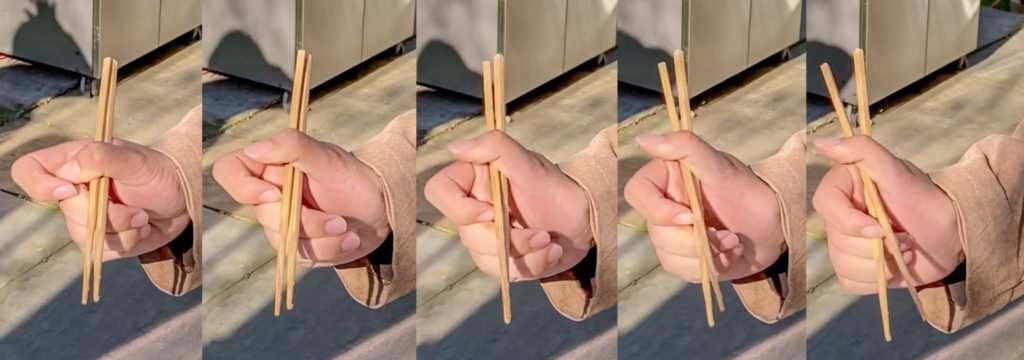
This practitioner does not extend the IP (Interphalangeal) joint of the thumb completely flat at the Open posture. But it does not affect the operation of Lateral Thumb Wrester at all. With Lateral Thumb Wrestler, the tip segment of the thumb is not used for anything. Only the base of the thumb engages both chopsticks through out the alternating motion.
Clutching chopsticks closed
When extending chopsticks apart, the index finger and the thumb base swing the top chopstick to the left, and under the top chopstick. This is quite different from the classic swing in sibling grips such as Lateral Chick. This underswing movement results, in turns, in the hand having to clutch chopsticks closed in a different way as well, when closing tips of chopsticks.
Following images show how a classic grip such as Lateral Chick clutches chopsticks closed. To bring chopsticks toward each other, the index finger and the middle finger pinch the top chopstick immobile. Then these two fingers bring the top chopstick down toward the bottom chopstick. At the same time, the base of the thumb pushes against the rear end of the bottom chopstick, in preparation for the impact from the top chopstick.

Following images show how an underswing grip such as Lateral Thumb Wrestler clutches chopsticks closed. Despite the similarity of the Abutting posture (below right) to that of Lateral Chick (above right), Lateral Thumb Wrestler uses completely different finger dynamics to clutch chopsticks closed, compared to Lateral Chick.
Following images illustrate this clutching movement step by step. In Lateral Thumb Wrestler, the two chopsticks appear to pivot at the base of the thumb. To close tips of chopsticks, Lateral Thumb Wrestler moves the thumb back to the front, as it bends both joints of the thumb. The thumb base clamps down on both chopsticks now, pinning them against the middle finger and the purlicue. This gives the illusion that the top chopstick pivots at the thumb base.

For this grip, clutching chopsticks shut is far easier than extending chopsticks apart, starting from the Abutting posture. Only the base of the thumb is needed. Following is how the second practitioner snaps the two chopsticks closed.

The speed at which fingers snap chopsticks closed can only be appreciated from this short video. This video has already been slowed down, so that motion can be registered by eyes and the brain. This breakneck move is only to be expected, of Lateral Thumb Wrestler. This is how one wins thumb wrestling championships.
Special compression posture with index finger as payload
Lateral Thumb Wrestler has a special, alternative form for the Compression posture. In the parent article Lateral chopstick grips, we discussed this Compression posture, where chopsticks pinch a piece of food, or payload, in between chopstick tips. Follow the tip of the index finger in the following video. Note how it lingers in between the two chopsticks throughout most parts of this video. We call this the Index Compression Posture.
The tip of the index finger remains in this between-chopsticks position, while the practitioner picks up food. The index tip also lingers in the same position when chopsticks are no longer holding food. In fact, at times the thumb base clamps down on both chopsticks, using mid sections of both chopsticks to pinch the index finger in place. This prevents the two chopsticks from snapping shut completely. As mentioned earlier, extending chopsticks apart starting from the Abutting posture is more complicated than snapping chopsticks shut. Here is another video showing the same, in slow motion.
Following images demonstrate this special posture from various perspectives.

Finally, we have a slow-motion capture of this practitioner picking up chopsticks, and placing them in the hand with dexterity and precision. The practitioner assumes the special compression posture in a blink of an eye, already ready to use chopsticks to pick up food.
Following pictures show the special Index Compression posture of Lateral Thumb Wrestler, seen from different angles.

Related grip: Scissorhand
Lateral Thumb Wrestler shares many similarities with Scissorhand Grip. Following are two key postures of Scissorhand. Its Abutting posture shown below left clearly identifies it as belonging to the Lateral family. But its Max open posture shows that the bottom chopstick is pushed far away downward, such that it no longer rests on the middle finger. In fact, only the base of the thumb holds the bottom chopstick at the Max open posture, and prevents it from falling off the hand.
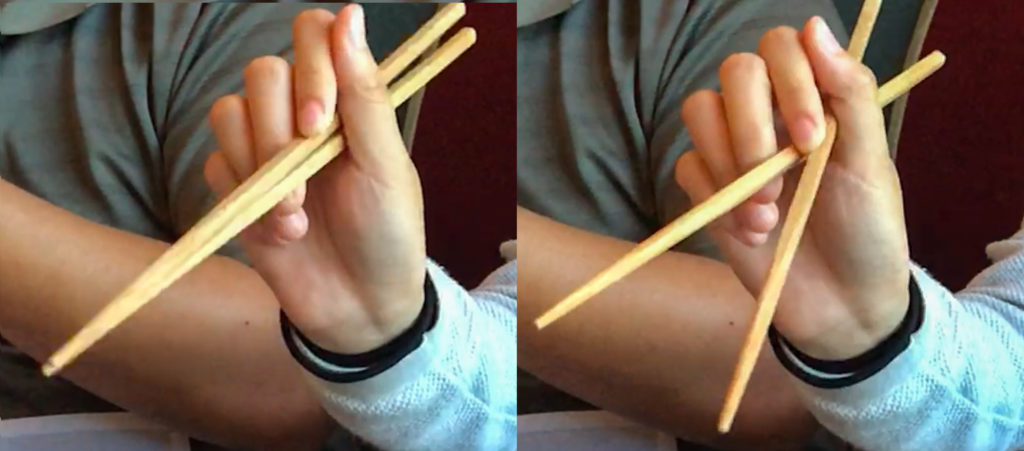
There is a clear resemblance between Scissorhand Grip and Lateral Thumb Wrestler. For comparison, the Abutting posture and Open posture of Lateral Thumb Wrestler is shown below. They look very similar to Scissorhand Grip. As mentioned, one subtle difference is how the bottom chopstick continues to rest on the middle finger at the Open posture, in Lateral Thumb Wrestler.
Another difference between Scissorhand Grip and Lateral Thumb Wrestler is how the index tip is used. The picture found below right shows the tip of the index finger being inserted between the two chopsticks, to nudge the top chopstick downward. That is not how the index finger works in Scissorhand Grip.
Update 2021-05: in popular culture
In May 2021 we analyzed an excellent episode on chopsticks and chopsticking by World Friends YouTube channel. We published a writeup of this review in YouTube episode on chopsticking from WorldFriends.
All three hostesses wield more than one chopstick grips. Two of three hostesses naturally use Lateral compression. The hostess Hyejin believes that she primarily uses Scissorhand. But actual observations show that she switches to Lateral Thumb Wrestler as often as she uses Scissorhand. These two grips differ only in how they extend chopsticks apart. Both grips clutch chopsticks closed with the same Compression posture.
It is possible that Hyejin wields many Lateral classic grips. But we don’t have enough video evidence of those. What we do have from the episode are images that clearly illustrate her use of Lateral Thumb Wrestler, shown below.

Taiwanese: 指頭母相偃
This grip is known as 指頭母相偃 (Chéng-thâu-bó sio-ián) in Taiwanese. Technically its full name should be 邊仔指頭母相偃 (Piⁿ-á chéng-thâu-bó sio-ián).

